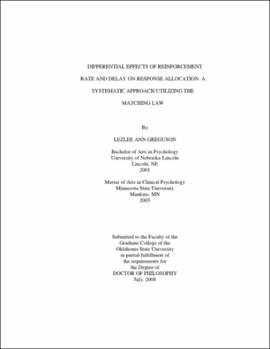| dc.contributor.advisor | Duhon, Gary J. | |
| dc.contributor.author | Greguson, Lezlee Ann | |
| dc.date.accessioned | 2013-11-26T08:34:30Z | |
| dc.date.available | 2013-11-26T08:34:30Z | |
| dc.date.issued | 2008-07 | |
| dc.identifier.uri | https://hdl.handle.net/11244/7415 | |
| dc.description.abstract | Scope and Method of Study: This study measured those reinforcement variables related to choice behavior and its impact on response allocation. This study addressed the two sensitivity variables of reinforcement (rate and delay) in matching law theory and attempted to elicit a sensitivity threshold for rate and immediacy of reinforcement. These two thresholds were then implemented concurrently to assess the influence on response allocation and the relative impact one variable (rate or immediacy) may have on the other. Five participants (four males and one female), between the ages of 6 and 11 years served as participants in this study. Percentage of math problems completed was used to measure response allocation. Each individual math problem presented on the math worksheets was associated with one of two visual cues. For each participant one cue (either circles or squares) was associated with a manipulation in rate or delay while the other cue was associated with no manipulation. Contingencies associated with each cue were randomly assigned to participants prior to beginning the study. Baseline phases were implemented in which contingencies associated with each cue were identical and consisted of the immediate delivery of reinforcement at a rate of one token for every 10 correctly completed math problems. For rate and delay threshold conditions, one cue or discriminative stimuli remained at baseline levels while the other systematically increased until percentage of allocated response shifted to at least an 80%-20% split in favor of the richer schedule. For the rate versus delay condition, both rate and delay thresholds were implemented concurrently to determine its impact on response allocation. | |
| dc.description.abstract | Findings and Conclusions: Results revealed that individualized rate and delay threshold could be determined and varied across participants. When comparing rate and delay thresholds, four to five participants chose to allocate response to the delay variable while one participant chose to allocate response to the rate variable. Thus, when reinforcement rate and delay were implemented on concurrent schedules, more participants chose to allocate responses to the schedule that allowed more reinforcement for fewer problems with delayed access to the reinforcer. One participant chose to receive less reinforcement for completing more problems with immediate access to the reinforcer. | |
| dc.format | application/pdf | |
| dc.language | en_US | |
| dc.rights | Copyright is held by the author who has granted the Oklahoma State University Library the non-exclusive right to share this material in its institutional repository. Contact Digital Library Services at lib-dls@okstate.edu or 405-744-9161 for the permission policy on the use, reproduction or distribution of this material. | |
| dc.title | Differential effects of reinforcement rate and delay on response allocation: A systematic approach utilizing the matching law | |
| dc.contributor.committeeMember | Stinnett, Terry A. | |
| dc.contributor.committeeMember | Poncy, Brian | |
| dc.contributor.committeeMember | Harrist, Amanda | |
| osu.filename | Greguson_okstate_0664D_2803.pdf | |
| osu.accesstype | Open Access | |
| dc.type.genre | Dissertation | |
| dc.type.material | Text | |
| dc.subject.keywords | matching law | |
| dc.subject.keywords | reinforcement rate | |
| dc.subject.keywords | reinforcement delay | |
| dc.subject.keywords | behavioral thresholds | |
| dc.subject.keywords | experimental research | |
| dc.subject.keywords | generalized | |
| thesis.degree.discipline | Educational Psychology | |
| thesis.degree.grantor | Oklahoma State University | |
